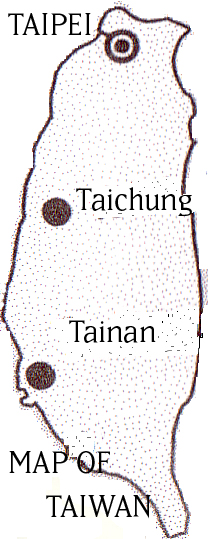|
Read 13043340 times
Connect me to:
|
I Remember TaipeiChinese Food in China, Hong Kong, and/or Taiwan
Spring Volume: 2011 Issue: 18(1) page(s): 13
 Taipei which means 'Taiwan North,' is the principal cultural and economic center of Taiwan; and now it is the country's capital. When I first arrived in February of 1982, a ride on a city bus--with no shock absorbers--cost 6 NT$ or fifteen American cents. Taipei which means 'Taiwan North,' is the principal cultural and economic center of Taiwan; and now it is the country's capital. When I first arrived in February of 1982, a ride on a city bus--with no shock absorbers--cost 6 NT$ or fifteen American cents.
Two dishes stand out from my first meal. The first is a little plate of tiny sardines with slivered red and green chili peppers in oil; the second, a warm sesame seed soup. Jars of this sardine appetizer can be found in Chinese grocery stores in Manhattan or Flushing but I have never had that sesame seed soup again. A favorite lunch was the simple and delicious lunchbox there called bian dang. It was provided by ubiquitous vendors in tiny trucks, magically appearing each workday on the city streets from 11 to 2. They were usually run by a husband and wife team who operated a small kitchen from the rear of their truck. For NT$ 40 or one US dollar, one could select one protein: a chicken leg or ji tui, a pork chop or pai gu, or a pork belly slab called kou rou. The chicken leg consisted of both drumstick and thigh; they were simply deep-fried. The pork chop was pounded flat, coated in flour and deep-fried, as well. The pork belly slab was marinated and braised in a rich dark sauce the Chinese call lu shui. This might be a master sauce or the type cooks in olden days would keep daily on their stovetops, replenishing it every night with the day's leftovers. A typical lu shui might consist of stock, soy sauce, rice wine, star anise, rock sugar, ginger and white pepper. Into the styrofoam container, a large scoop of rice would be placed, then the selected protein followed by three to four vegetable dishes. Free options could include a ladle of the sauce over your mound of food and even a lu shui hard-cooked egg. Today in Taipei, the lunch box trucks have disappeared due to health regulations. They have been replaced by indoor lunch-box shops. And in a more environmentally conscious Taiwan, some people today carry their own chopsticks around with them. Another fond memory of Taipei is of the 'Night Markets.' There were at least six, open roughly from 4 pm until 2 am. Standouts here included oyster omelets, stinky tofu topped with pickled cabbage and sauce, fried buns, Taiwanese sausages, candied sweet potatoes, and in the summertime scoops of shaved ice atop taro, red or green beans or dou hua or bean curd flower served with a slightly sweet, clear syrup topped with almonds or fruit. Taipei was where I also saw for the first time an honor system Chinese vegetarian restaurant. After self-selecting from among thirty or more different dishes, your plate was weighed, you were informed of the cost and trusted to pay by dropping your money into a jar at the end of the line. No mention of Taipei and Taiwan is complete without mentioning its bountiful supply of homegrown fruit. In addition to papaya and mangoes, there were three varieties each of pineapples and guava. More exotic offerings included loquats, litchi, pomelo, sand pears, sugar apples, and star fruit, correcltly known as carambola. Of course, today there are Starbucks everywhere in Taipei, but in 1982 it was Mr. Browns Coffee, canned, and ice cold with milk already added. It went very well with the ice cream sticks with corn kernels. These days, a thirty billion dollar rapid transit system is in place with over eighty stations and nine lines. The average fare is a dollar and a quarter, US. The ride is smooth and announcements are made in Mandarin, Taiwanese, Hakka, and English. Yes, I do remember both Taipei and Taiwan; and I remember them fondly!
_____
Michael Gray is a licensed NYC Department of Consumer Affairs tour guide. He specializes in Chinatown, and knows it well. He lived in China, Hong Kong, and Taiwan for ten years, studied Chinese for three of them, and also has three years of experience as a cook in a Chinese restaurant.
�� |

 Taipei which means 'Taiwan North,' is the principal cultural and economic center of Taiwan; and now it is the country's capital. When I first arrived in February of 1982, a ride on a city bus--with no shock absorbers--cost 6 NT$ or fifteen American cents.
Taipei which means 'Taiwan North,' is the principal cultural and economic center of Taiwan; and now it is the country's capital. When I first arrived in February of 1982, a ride on a city bus--with no shock absorbers--cost 6 NT$ or fifteen American cents. 